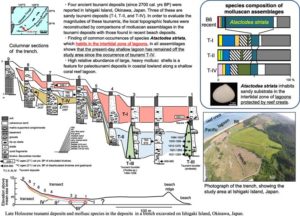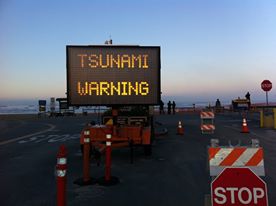Remembering 3.11.2011
Tsunami is a serious threat to all coastal and low lying areas. As citizens being prepared in the USA means to be ready. However we do not have tsunami drills and you may only see the tsunami blue and white warning signs but may not pay much attention to them. But you should.
The Great Tohoku Earthquake had struck 20 minutes earlier at 9.2 on the Richter scale. This country suffered a volcanic eruption, nuclear disaster, multiple earthquakes and eleven tsunami waves including subduction (where the land mass drops below its normal elevation).
You are witnessing below a revised video of the first Tohoku tsunami wave. There were 11 waves total that struck throughout the night.
We can observe the timelines on the water rise and current draw.
You will have to bench press 500 lbs., to move yourself off a fixed object in 12 mile per hour of flow.... however with tsunami that goes out the door, because these currents are not normal river or water flow currents.
They are layered and sustained with increasing draws, rises and debris flow behind them as the waters surge forward. Each time the tsunami wave begins to recede, the debris pile increases and moves inward and outward of the water draw, fire, explosions and electrical shock risk increases and the intersection of outgoing current/waves/debris with incoming current/waves/debris is more than deadly.
Japan has an incredible emergency service response built in for earthquake and tsunami incidents. Their government focuses on emergency response for their responders and citizenry. Even so, catastrophic events such as these each person must be prepared for self rescue and self survival for a period of two weeks or more.
Notice how much valuable time their tsunami sea wall gave their residents to seek high ground in the video. Perfect! You can do a lot to save yourself in a mere few seconds. Even more so if you prepare your mindset in advance so you do not go into shock and second guess your actions or others.
Imagine you are at home, asleep, traveling or at work. Suddenly without warning an Earth event occurs! How will you respond with your location? Will you pull your vehicle over and stop, will you put on shoes at the foot of your bed, or is the bed fallen over, is there glass on the floor, will you lost all contact with loved ones, will your phone go dead?
If the phone services are still operable your phone should light up if you registered for alerts. Save your battery don't text people at this critical point, do some research quickly. Find out what is going on by monitoring the weather, or links you are subscribed to. Phone lines will clog up rapidly and access may diminish or not exist at all. Electricity can be shut down and a total black out occurs.
Remember you may have the emergency notification system go into effect, you can expect a Presidential, NOAA, FEMA, ALERT system update or multiples at one time via text. You may also hear very very very loud sirens going off. It's unnerving but designed to wake us up and get us moving now!
Tsunamis waves
Take a CERT course and be involved in your local community:
Community Emergency Response Team
Sign up for digital alerts on your phone by following this link:
US Tsunami Warning Centers
Prepare for Survival
For our Safety Behavior it is very important to monitor all the Pacific Ocean surrounding continents for Volcanic and Earthquake activity. If a large land mass shears off into the ocean, expect a tsunami.
Tsunami water height may not be a wave height per se, but energy released that is pushing trillions of cubic yards of water through molecular structure of fluid dynamics.
We see this in simple ways in our bathtubs or while washing our dishes by dropping an object into the water with the surrounding rings/waves of water pulsing outwards.
What we can do is monitor these incidents. Have our emergency contact plan worked out in advance with family and employees/ers. Have our animal evacuation plan ready to be put into effect.
Have your 2 week supply of rations/water ready, and a stash in a vehicle. Use dehydrated foods like Mountain House to protect the food supply in foil packages.
Get yourself a solar powered charging system.
Have a place to meet, such as a surrounding high ground elevation zone.
Keep at least 50% fuel capacity in your vehicle tank at all times, cannot help you with electrical cars, don't own one, but figure that out. Roadways in highly populated areas or one way roads may be severely congested and not move at all, so think about alternative escape routes and locations.
Be prepared to live simply and with gratitude during catastrophic events. Reality will change in one second, be ready to adjust.
Remain positive. This is the most important ingredient is your behavior towards disaster. Your positive is a rabid increase of good.
Now that you have viewed this, play in your mind how you would have responded in this location with the news you had and resources.
What would you have done?
How would you emotionally deal with the reality in front of you as witness?
How would you manage casualties, fatalities and rescues?
How would you manage your mindset and thoughts for those who perished or you could not help?
Prepare yourself now by playing movies or reruns in your head on how your safety behavior is going to be.
Some day you may have to rely upon your personal training.
After the disaster you will need a basic survival plan for the next two weeks, one month, or 3 months. You will have to shed a lot of fears or manage the process one hurdle at a time. Hope will be your strongest ally.
Continually give yourself hope and focus on your wins.
And the hard aspect of recognizing nature as its own life force is it really doesn't show us its absolute might and potential. We do have a lot to be thankful for, as catastrophic events are another level unimaginable altogether. This is a power stroke of earth and water we witnessed in our lifetime.
These catastrophic events affect the entire ecosystem and humanity on many levels. We have plenty of alerts and warnings in the past 20 years that have given us ample time to prepare and be focused on our behaviors. But is it happening? Have you done it yet?
A safety behavior begins with an evaluation of where you are currently and what you can do to be as ready as is reasonable when disaster strikes.
It may not be a perfect road map, but better to practice now and be ready as none of us will escape tragedy in our lifetime.
Be the person in the room that everyone can depend upon.
Tsunami History Review

Four ancient tsunami deposits were identified in a trench excavated on Ishigaki Island, Okinawa, Japan. Three of the tsunami deposits (T-I, T-II, and T-IV) consist of calcareous sand beds, whereas the other (T-III, located stratigraphically between T-II and T-IV) consists of boulders.
Deposit T-I was caused by a tsunami in 1771. 14C dating, together with the elevations of the landward margins of these sandy tsunami deposits, suggests that tsunamis II and IV were similar in size to the 1771 tsunami, although the influence of local topographic features on the magnitudes of tsunamis has not yet been examined. This study reconstructs the local topographic features by comparing the molluscan assemblages incorporated within the tsunami deposits with those in recent beach deposits.
The presence of species that inhabit the intertidal zone in lagoonal settings in all the assemblages indicates that the present-day shallow lagoon has been present off the study area since the occurrence of tsunami T-IV, which supports the previous hypothesis that the magnitudes of the 1771 tsunami and tsunamis II and IV were similar. These molluscan assemblages also suggest that a high relative abundance of large, heavy mollusc shells is a feature of the paleotsunami deposits in the coastal lowlands found along the shallow coral lagoons.
Posted 1.6.2019
Have any questions? Join the Rescue Water Craft Association
and discover what your community is doing to modernize standards, safety and reduce liability!
Join the Rescue Water Craft Association
Content Creator: Shawn Alladio cares most about her community and the culture surrounding the safety of event service providers and Rescue Water Craft operators, working hard and dedicated towards protecting their reputation, distributing safety information and continuing to train these amazing individuals to the highest standards of care.
Use at your own risk. Please take a qualified Rescue Water Craft training course and maintain proper records and respect all the PWC, RWC, PPE, and gear OEM manufacturer warning labels and cautions.
